If you’re always looking for ways to add healthier foods to your family’s diet you can feel good about serving, juicing is a great way to do that! It’s quick, easy, and you can pack a lot of nutrients into a small glass.
A refreshing and tasty green juice with a balance of tang and sweet for a feel-good boost to your day!

What is green juice and what are the benefits of drinking it?
I’m a big proponent of getting the nutrients we need by eating whole food. In general, separating or isolating nutrients is less effective for overall nutrition than eating food closest to its natural, whole state.
When eating fruits and vegetables we get fiber along with their nutrients and both are important so I don’t juice to replace meals. Instead, I juice fruits and vegetables as an occasional supplement or as a concentrated nutrient boost when dealing with illness or recovering.
When our health is compromised or we’re recovering from something like surgery, we may not be able to consume all that we need at mealtime.
The benefit of drinking juiced vegetables and greens is it allows us to easily assimilate the nutrients our body needs for recovery without taking a lot of energy for digestion or risking intestinal discomfort during a critical time of healing.
Supplementing our diet with a glass of juiced vegetables in the morning or afternoon as a snack also gives us peace of mind when other meals may be rushed or healthier choices aren’t available.
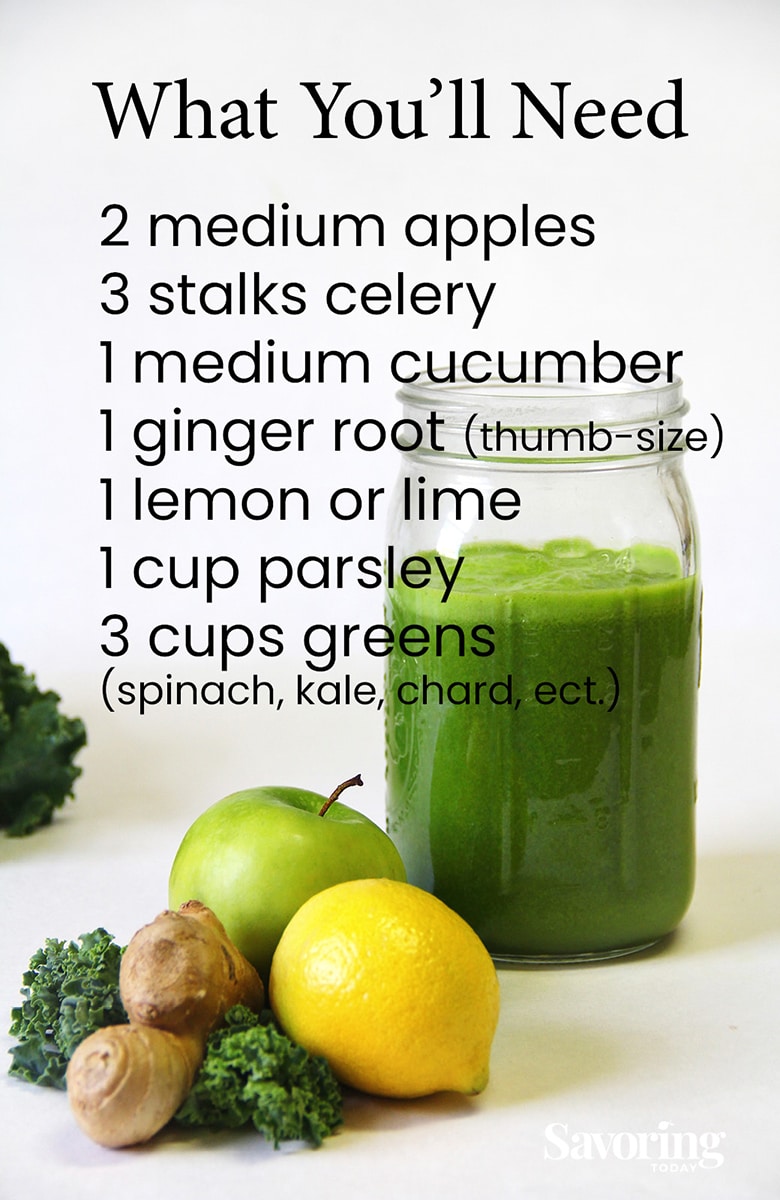
Selecting ingredients for great-tasting fresh green juice
I’m a big fan of good-for-you food, but it has to taste good too. These recommendations will help guide you in selecting ingredients for optimum yield and flavor. We find a good mix of neutral, bitter, earthy, and sweet is ideal.
A good rule of thumb is to use only enough fruit or sweeter vegetables like carrots to make vegetable juice palatable. Concentrated fruit juice can cause spikes in blood sugar, which is a burden on your system, so limit the amount of fruit.
In general, I do not use cruciferous vegetables like Brussels sprouts, broccoli, or cabbage for juicing as they tend to be difficult to digest and not especially appealing in flavor. I prefer these fiber-rich veggies grilled or roasted.
Best Vegetables and Greens for Juicing
- beets (sweet, avoid if low blood pressure)
- carrots (sweet)
- celery (neutral)
- cilantro (slightly bitter)
- cranberries (very tart)
- cucumber (neutral)
- leefy greens such as spinach, chard, kale (bitter)
- parsley (earthy)
- summer squash
- wheatgrass (earthy)
Best Fruits and Roots for Juicing
- apple (use green apples for lower sugar)
- kiwi (tart, sweet)
- lemon (sour, bitter)
- lime (sour, bitter)
- grapes (sweet, high in sugar)
- grapefruit (sour, sweet)
- ginger (spicy)
- melon (sweet, high in sugar)
- orange (sweet, high in sugar)
- pomegranate (sweet, tangy)
- tangerine (sweet, high in sugar)
- tomato (slightly sweet, earthy)
- turmeric (bitter)
Important Note: This information is based on my opinion of how to make great-tasting juice and is not given or intended as medical advice.
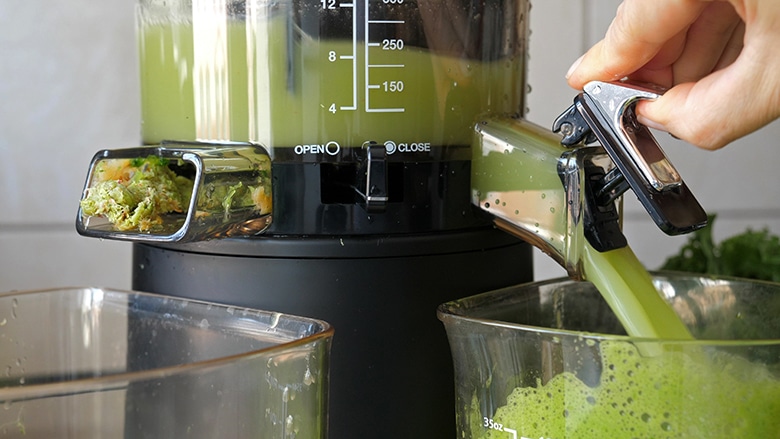
The Best Juicer For Juicing Fresh Fruits and Vegetables
Masticating juicers extract the most juice. However, if you’ve never juiced before, don’t worry about what kind until you know it is something you will do consistently. Survey your friends (you know which ones to ask) to borrow one for just a couple of weeks or even a month. Then juice.
See if it is something you can commit to, as well as what you like and don’t like about the juicer you borrow, which will give you a better idea about the features you’d prefer. The best juicer is the one you will use.
For detailed information and a comparison of juicer types, check out justjuice.org.
Tips for Juicing Fresh Fruits and Vegetables
- Juicing is not a substitute for eating; rather it is a nutritional boost like a vitamin or supplement. Incorporate juices, but don’t overdo.
- Use only enough fruit to make any green juice palatable. Concentrated fruit juice can cause spikes in blood sugar, which is a burden on your system, so limit the amount of fruit. On the subject of avoiding fruit juice, the same goes for smoothies. Fresh vegetable juice is an ideal base for smoothies too.
- If you juice often (more than 3 x week), rotate the vegetables and greens to add a variety of nutrients.
- Choose organic produce for juicing. Everything gets concentrated in the juice; you don’t want pesticides in the mix.
- Use frozen berries instead of fresh will yield more juice from the berries.
- For the most appealing color, avoid mixing vegetables and fruits that are red and purple with deep green varieties. This combination turns brown and is less appetizing.
- Fresh juice should be consumed as soon as possible, however if you save it, do so in a container with little air and no longer than 48 hours for best results.
- Freeze any leftovers to use as a base for smoothies.
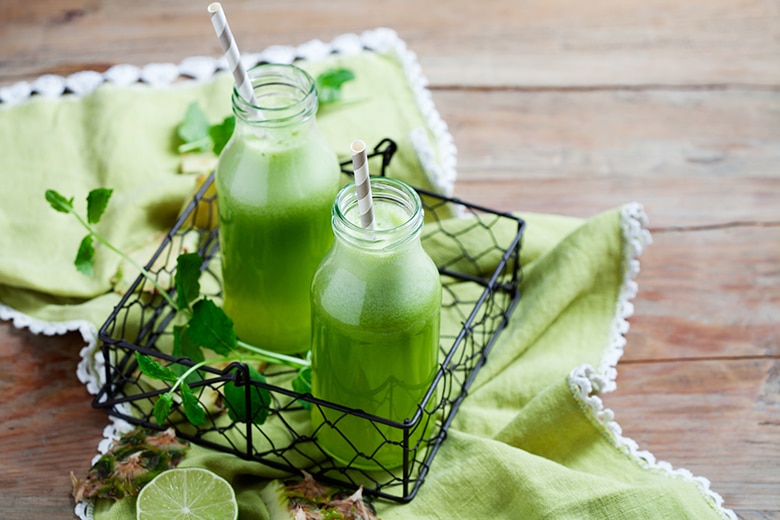
10 Ways to Use Leftover Pulp from Juicing
- Puree pulp for soups or stock
- Add pulp to muffins or quick breads
- Add pulp to smoothies
- Make juice pulp crackers
- Mix into burgers or meatloaf, this depends on how sweet it is
- Mix into morning oatmeal or these no-bake oatmeal cookies
- Blitz it into Caramelized Onion Dip for a creamy cracker spread
- Add to spaghetti sauce or chili
- Feed chickens or ducks
- Compost or mulch fresh juice pulp right into the soil around your plants and trees for fertilizer. Juiced pulp decomposes quickly considering it has already been broken down.
More Nourishing Recipes You’ll Love
- Mocha Breakfast Smoothie
- Fruit and Nut Granola Bites
- Cinnamon-Spiced Almond Butter Dip
- Cranberry Orange Muffins (Grain-Free)
- Sweetly Spiced Pecans
Fresh Green Juice
Ingredients
- 2 medium apples , seeds removed, cut into wedges
- 3 stalks celery , coarsely chopped
- 1 medium cucumber , 6-7 inches long, cut into spears
- 1/2 inch ginger root
- 1 small lemon or lime , seeds removed, cut into wedges
- 1 cup parsley stems and leaves , loosely measured, chopped into 1-inch segments
- 3 cups assorted greens (spinach, kale, beet greens, chard, etc.), loosely packed, chopped into 1-inch segments
Instructions
- Cut the produce to fit the feeding tube of a juicer. Process the produce in the juicer, then stir well and serve in two 16 oz. glasses.
Notes
Recipe TIPS
- Juicing is not a substitute for eating; rather it is a nutritional boost like a vitamin or supplement. Incorporate fresh juices into an overall healthy diet, but don’t overdo it.
- Use only enough fruit to make any green juice palatable. Concentrated fruit juice can cause spikes in blood sugar, which is a burden on your system, so limit the amount of fruit. On the subject of avoiding fruit juice, the same goes for smoothies. Fresh vegetable juice is an ideal base for smoothies too.
- If you juice often (more than 3 x week), rotate the vegetables and greens to add a variety of nutrients.
- Choose organic produce for juicing. Everything gets concentrated in the juice; you don’t want pesticides in the mix.
- Using frozen berries instead of fresh will yield more juice from the berries.
- For the most appealing color, avoid mixing vegetables and fruits that are red and purple with deep green varieties. This combination turns brown and is less appetizing.
- Fresh juice should be consumed as soon as possible, however, if you save it, do so in a container with little air and no longer than 48 hours for best results.
- Freeze any leftovers to use as a base for smoothies.
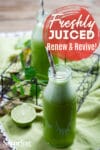
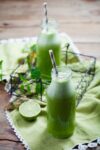
Hafij says
As someone who is always looking for ways to incorporate more nutritious foods into my diet, I found this article on fresh green juice to be incredibly helpful. I appreciate the tips on selecting ingredients, the benefits of juicing, and the best juicer options. Overall, a great resource for anyone interested in juicing!
John / Kitchen Riffs says
Love the color of this! And so healthy, too — we’re all looking for healthy stuff at the moment. 🙂
mjskitchen says
Well this is a very healthy way to start the day. Love the addition of the apple of counter the bitterness that I can sometimes taste in raw greens.
Julie says
While greens are the healthiest food on the planet then fruit comes in a close second. Perhaps you need to be slightly cautious of adding fruit if you are diabetic but don’t let that scare you away because they pack nutrition that helps solve that problem.
Char says
I just started juicing and this was so helpful!
ryan says
Awesome juicing tips you’ve got here.
I agree that using too much fruit is a very common mistake that people make.
Like you, I like to add just enough fruit to take the bitter edge off of green veggies.
Although some veggies like carrots can be quite sweet all on their own.
karen (Back Road Journal) says
I’m so happy to know that you are truly on the mend and feeling much better. It sounds like you are doing everything possible to fully recover that that is so important.
April @ The 21st Century Housewife says
I’m so glad you are feeling so much better, Judy. That is wonderful! It was an honour to do a guest post for you – I really enjoyed it. Thank you for the shout out 🙂
This is an excellent post and I’ll definitely pin and share it. I’ve wondered about juicing and was interested to learn more. Your practical advice is really helpful!
Take care and I’m so glad you are back to blogging and feeling better 🙂 x
Raymund says
Nice to see you back, hope you get even better soon., We missed you
Carol at Wild Goose Tea says
I am new to your blog, since the beginning May. I knew you were having some health issues, but not much more. However, I am a HUGE proponent of gratitude and prayers. So I am smiling as I am typing. So pleased for you. I say a grateful thankful for you to add to the good vibration!
mjskit says
Judy, I’m so glad that you are doing so well and that you have your life back. What a great feeling! I haven’t done much juicing but have known some serious juicers. I’m glad to see you say that it isn’t a substitute for food or eating. 🙂 I know one person who only drank juice and is now seriously anemic. Your juice is such a pretty color and I love the ingredients! I’m sure it would provide a nice boost.
Maureen | Orgasmic Chef says
I have a juicer with masticating rollers and I love it. Several years ago I began juicing and within 6 months I’d reversed the liver damage I’d experienced through an illness. The concentrated goodness did the trick. I will admit that just green tasted so nasty that I couldn’t get it down so I made juice I’d drink as long as it had beets, spinach, red cabbage and ginger.
So glad to know you’re really on the mend!
Judy Purcell says
Hi Maureen, the liver does so much, truly an amazing organ. Glad to hear you too had a good experience with juicing, it really does help. I haven’t tried red cabbage yet, but I’m with you on the beets. We tried a couple of juices with beets and carrots to replace the apple that were quite good.
Linda says
Judy, It’s so wonderful to hear your feeling better and on your way back! I strongly believe in juicing and have specifically used it during times of healing. That instant rush within your body of gorgeous nutrients first thing in the morning and an afternoon lift I so truly believe heals and regenerates your body. Can’t wait to see what recipes you’ve been dreaming up! It’s a good sign you are on your way!
Judy Purcell says
Hi Linda! Yes, when so much energy is going toward healing (or life in general), a glass of green juice is a nice boost in the middle of the day. Thanks again for the guest post ~ (BIG HUG).
John@Kitchen Riffs says
So glad you’re getting healthy again! What an ordeal you must have had. In general, I’m with you on whole foods — why take a bunch of really good ingredients and turn them into liquid when you could just eat them? But your point about making them easier to absorb when one’s health is compromised (or one wants a healthy snack) is a good one. Anyway, this looks great. And welcome back!
Judy Purcell says
Thanks John, though it was a rough time, I consider myself fortunate to feel as great as I do and be where I am. 🙂